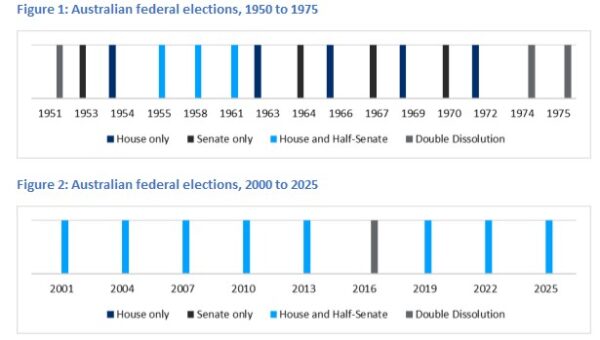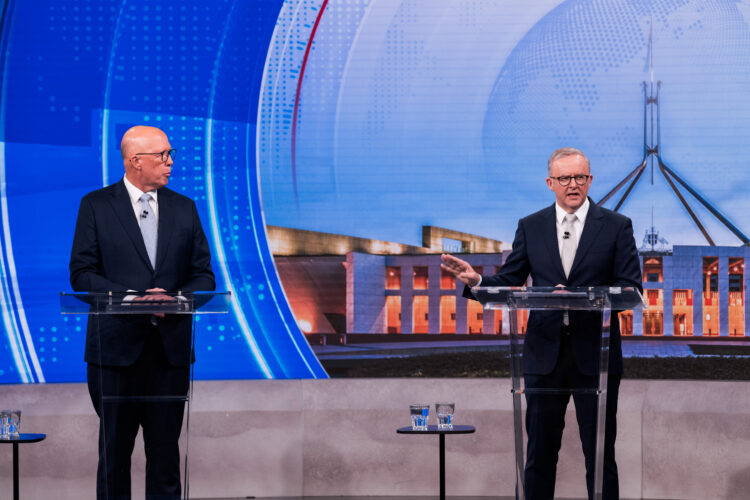Election entrée: think three-year terms are too short? Spare a thought for generations past.
Bill Browne
Joshua Black
Complaints about the brevity of three-year parliamentary terms are common in Australia.
Earlier this year, Business Council of Australia president Geoff Culbert told the AFR that Australia is “permanently in election mode” and our three-year term limits are “too short”. The prime minister and opposition leader both say they support four-year terms, though they’re not willing to chance their arm on a constitutional referendum to make it happen.
In the last 25 years, Australia has had eight (soon to be nine) federal elections. If that sounds like heavy going, spare a thought for generations past. From 1950 to 1975, Australians voted in 15 federal elections, including four separate half-Senate elections.
This is to say nothing of the four separate referendums held between 1950 and 1975, compared with just one in the period from 2000 to 2025.
When Gough Whitlam joked that he was enjoying a rare “non-election year” back in 1985, he had a point.

The Constitution requires elections for the House of Representatives at least every three years, or more specifically, no more than three years after Parliament first meets. By convention, elections are called at a time of the prime minister’s choosing. Strictly speaking, the Constitution actually gives the Governor-General that power, and they need to be persuaded before a prime minister can race off to the polls.
The Senate is a different beast altogether. Inspired by the staggered terms of the US Senate, Australia’s constitutional drafters chose to put only half of the Senate up for election every three years. As a result, senators enjoy six-year terms. This was to give it a more “perpetual existence” than the lower house with its short-term majorities.
Senators’ terms normally begin on 1 July after an election is held. At a double dissolution, when the whole Senate is dissolved alongside the House to solve deadlocks between the two houses, senators’ terms are backdated to 1 July of the previous year. Governors-General rely on careful legal advice before agreeing to double dissolution elections, not least because the Constitution sets careful criteria for when they can and can’t be held.
There’s nothing in the Constitution that requires House and Senate elections to be ‘in sync’. If a double dissolution is awkwardly timed, it can mean that a half-Senate election is required more than a year earlier than the next House election.
For example, a double dissolution election in April 1951 knocked the two houses off kilter, prompting a half-Senate election before 30 June 1953. An early House of Representatives election in November 1963 did the same. Half-Senate elections in 1953, 1964, 1967 and 1970 seemed to be, in the words of one Governor-General, a “major public opinion poll” on the government of the day.
In 1963 prime minister Robert Menzies asked the Governor-General to dissolve the House roughly eight months early. He offered a combination of strategic and policy justifications (the global fight against Communism was heating up in Asia) and expedient justifications (the previous election had left his government vulnerable in the lower house, and the times now suited him). His decision initiated a decade of un-synchronised elections for the two houses.
There’s no right or wrong answer about how often Australians should vote. But election timing matters. Unlike most of Australia’s states, the federal parliament does not have fixed terms. This means prime ministers get to pick the date that best advantages them. Few of us stop to think how unusual it is that a competitor also enjoys control over the starter’s gun.
Prime ministerial prerogative is also one of the reasons that three-year terms feel so much shorter. Thanks to early elections, the average term is closer to two and a half years rather than three. Journalists play a part by turning the last year of any parliament into an election-predicting contest. The Australia Institute’s Democracy Agenda for the 48th Parliament recommends fixed terms as for election timing. Parliamentarians could start by agreeing at the beginning of the 48th parliament to run full-term. This would remove an unfair incumbency privilege and create a more level playing field for new candidates and parties preparing to contest elections.
Elections are important. Their timing should be fixed. This would make the playing field more level for all candidates. It would also make those three-year terms feel a little less short.


